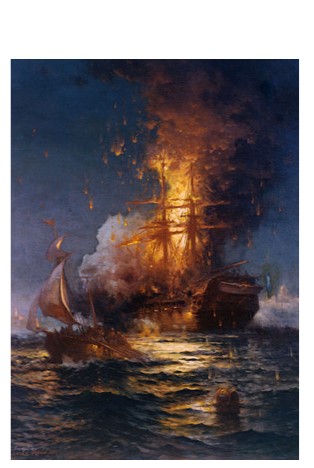
Burn the Boats
By Craig Huntington (to see original, click HERE)
I’ve always said that the difference between history’s boldest accomplishments and its most staggering failures is often, simply, the degree of someone’s commitment.
It’s making the decision to go all in to achieve something important.
You know… jump in with both feet.
Go big or go home.
And a personal favorite: Burn the Boats.
I’ll explain.
The story goes that back in the early 1500’s the Spanish had made several expeditions from Cuba to the Yucatan and returned with fascinating tales of a very cultured Mayan society that was loaded with gold riches. As you can imagine, the gold was pretty appealing to the Spanish. So, the Spanish governor of Cuba appointed Hernán Cortés, the Spanish conquistador, to lead a new expedition to the Yucatan.
Cortés’ deal was that the governor would provide two or three ships, but Hernán would need to come up with the cash to fund the operation. Well, Cortés was committed, and the Spanish had gold fever. In a couple of weeks Cortés had two ships, a brigantine, 300 men and was flush with cash.
In fact, Cortés moved so quickly and boldly that the governor was alarmed at the scale of his preparations and feared losing control of the expedition. He sent orders to remove Cortés from his command, but when Cortés caught wind of the governor’s plans, he decided to set sail at dawn on the morning of February 18, 1519. The governor arrived at the shoreline that morning, determined to stop the expedition, but Cortés ignored his protests and gave the order to sail.
After disembarking at Potonchan where Cortés and his men fought and drove off 400 Indian warriors, the expedition moved on to the Isle of Sacrifices. Several days after their arrival, the steward of the great King of Mexico, Montezuma, arrived to greet Cortés and make sure that he received the royal treatment: food and supplies, gifts of precious stones and more.
Cortés introduced himself as the ambassador of a king who ruled “the greater part of the world,” and provided a very dynamic and intimidating demonstration of his guns and horses. That sent Montezuma’s messengers back to the emperor where they reported the threat.
In the interim, Cortés weighed his options. He wanted to see the enchanted, treasure-filled city of Tenochtitlan (home to Montezuma) that was 200 miles away. He was a fugitive, facing imprisonment or death, for ignoring the governor’s orders to stop the expedition. He also understood that some of his men were still loyal to the governor of Cuba and were considering seizing a ship and heading home. For Cortés, there was only one way forward: conquering and settling part of the land.
So, he burned the boats. And went to Tenochtitlan.
History reveals that Cortés wasn’t the only individual to burn the boats to clearly communicate to troops “there’s no going back.” Several other military leaders including Alexander the Great have given orders to burn the boats.
In my book Risk: A Road Worth Traveling, I share my own burn the boats experiences – from investing every cent I owned (and borrowed) into my own rock and roll club in my early 20’s to leaving the security of a thriving business I started to pursue a totally new venture in my late 40’s.
I’ve said that planning is an important part of living well; it is necessary to conducting business successfully. However, there is no way you can predict the future. There is no way you can completely mitigate the possibility of failure. And that makes it even more critical to commit to the path you’ve chosen so that you don’t get sidetracked or discouraged by the inevitable distractions that will rise up to meet you.
Make the decision to accomplish your objective.
And burn the boats.
